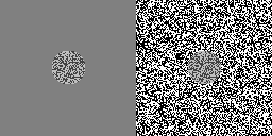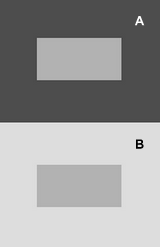Chubb illusion
Chubb Illusion is a visual phenomenon that illustrates the intricacies of human perception and how our brains interpret lightness and contrast. This illusion was named after Charles Chubb, who, along with colleagues, first described the effect in scientific literature. The Chubb Illusion demonstrates that the perceived brightness of an object can be influenced by the texture and contrast of its surrounding area.
Overview
The Chubb Illusion occurs when a textured surround, consisting of randomly distributed black and white dots, encloses an area of uniform gray. Observers typically perceive this central area as being lighter or darker than it actually is, depending on the contrast of the surrounding texture. If the texture is of high contrast, the central area appears lighter than it actually is. Conversely, if the surrounding texture is of low contrast, the central area seems darker. This effect highlights the challenges the visual system faces when trying to determine the lightness of an area without being misled by surrounding textures and contrasts.
Mechanism
The underlying mechanism of the Chubb Illusion involves the visual system's processing of contrast and texture. The human visual system is highly sensitive to contrast differences, which often provide essential information about the environment. In the case of the Chubb Illusion, the visual system is thought to use the contrast information from the surrounding texture to make inferences about the lightness of the central area. This process is influenced by the visual system's attempt to discount the shadowing effects that would typically cause variations in brightness and contrast, leading to the misperception of the central area's lightness.
Significance
The Chubb Illusion is significant in the field of visual perception because it provides insights into how the human brain processes complex visual scenes. Understanding this illusion and others like it can help researchers develop better models of visual processing and contribute to the design of more effective visual displays and artificial intelligence systems capable of visual recognition. Additionally, studying the Chubb Illusion can aid in diagnosing and treating visual perception disorders.
Related Illusions
Several other illusions share similarities with the Chubb Illusion, such as the Simultaneous Contrast Illusion, the Checker shadow illusion, and the Ebbinghaus Illusion. Each of these illusions reveals different aspects of how contrast, surrounding context, and prior knowledge influence our perception of lightness, size, and shape.
Conclusion
The Chubb Illusion offers a fascinating glimpse into the complexities of visual perception, demonstrating how our brains interpret and often misinterpret visual information based on the context provided by surrounding textures and contrasts. By studying this and related illusions, researchers continue to uncover the sophisticated mechanisms underlying human perception, contributing to our understanding of the human mind and the development of technologies that mimic or augment human visual capabilities.
This article is a psychology-related stub. You can help WikiMD by expanding it!
Transform your life with W8MD's budget GLP-1 injections from $125.
W8MD offers a medical weight loss program to lose weight in Philadelphia. Our physician-supervised medical weight loss provides:
- Most insurances accepted or discounted self-pay rates. We will obtain insurance prior authorizations if needed.
- Generic GLP1 weight loss injections from $125 for the starting dose.
- Also offer prescription weight loss medications including Phentermine, Qsymia, Diethylpropion, Contrave etc.
NYC weight loss doctor appointments
Start your NYC weight loss journey today at our NYC medical weight loss and Philadelphia medical weight loss clinics.
- Call 718-946-5500 to lose weight in NYC or for medical weight loss in Philadelphia 215-676-2334.
- Tags:NYC medical weight loss, Philadelphia lose weight Zepbound NYC, Budget GLP1 weight loss injections, Wegovy Philadelphia, Wegovy NYC, Philadelphia medical weight loss, Brookly weight loss and Wegovy NYC
|
WikiMD's Wellness Encyclopedia |
| Let Food Be Thy Medicine Medicine Thy Food - Hippocrates |
Medical Disclaimer: WikiMD is not a substitute for professional medical advice. The information on WikiMD is provided as an information resource only, may be incorrect, outdated or misleading, and is not to be used or relied on for any diagnostic or treatment purposes. Please consult your health care provider before making any healthcare decisions or for guidance about a specific medical condition. WikiMD expressly disclaims responsibility, and shall have no liability, for any damages, loss, injury, or liability whatsoever suffered as a result of your reliance on the information contained in this site. By visiting this site you agree to the foregoing terms and conditions, which may from time to time be changed or supplemented by WikiMD. If you do not agree to the foregoing terms and conditions, you should not enter or use this site. See full disclaimer.
Credits:Most images are courtesy of Wikimedia commons, and templates, categories Wikipedia, licensed under CC BY SA or similar.
Contributors: Prab R. Tumpati, MD



